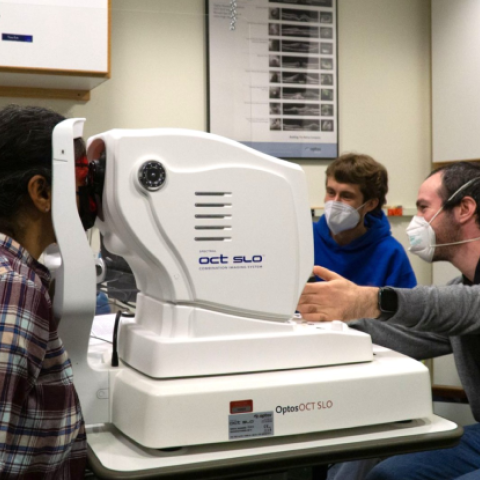
- Principal Investigator:
- Steve Heinen
The decision to make or withhold a saccade has been studied extensively using a go-nogo paradigm, but little is known about the decision process underlying pursuit of moving objects. Prevailing models describe pursuit as a feedback system that responds reactively to a moving stimulus. However, situations often arise in which it is disadvantageous to pursue, and humans can decide not to pursue an object just because it moves. This project explores mechanisms underlying the decision to pursue or maintain fixation. Our paradigm, ocular baseball, involves a target that moves from the periphery toward a central zone called the "plate". Observers must pursue the target if it intersects the plate (strike), or maintain fixation if it bypasses the plate (ball). We have revealed a neural substrate underlying this decision process in an eye movement region in frontal cortex, the supplementary eye fields (SEF).
Our preliminary human behavioral data has revealed several novel factors that affect the decision to pursue or fixate. One factor is priming, in which past experience influences current behavior. Preceding strike trials caused observers to commit more pursuit errors on ball trials, while preceding ball trials rarely caused fixation errors on strike trials. This implies that priming in the pursuit system is stronger than priming in the fixation system, although preceding fixation trials still appear to affect pursuit dynamics by increasing pursuit latency and decreasing open loop gain. The effect of priming is strong when strike and ball trials are randomized, but can be overcome to a degree by knowledge of trial sequence, such as when strike and ball trials alternate predictably. This is surprising, since in previous work involving visual search tasks, priming dictated behavior even when trial sequence was known. It is possible that the go-nogo rule involving the plate activates a cognitive region of the brain; however, even when the rule is removed and simple pursuit and fixation trials alternate predictably, trial sequence knowledge helps pursuit. This suggests that the fixation mechanism also plays a role in overcoming priming, since removing fixation trials and simply alternating the direction of pursuit renders priming dominant once again. In addition, we have evidence for an impulsive aspect to pursuit that is consistent with the reactive, motion-driven models. The fixation mechanism, which appears to be rooted in cognitive circuitry, then moderates the pursuit impulse. These projects are ongoing in the laboratory.

